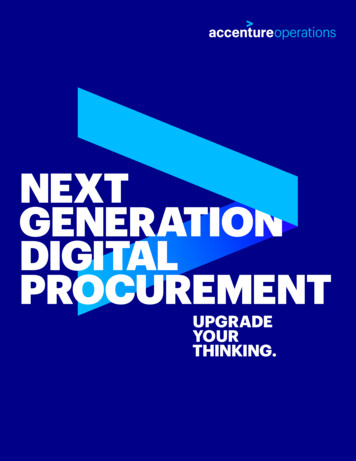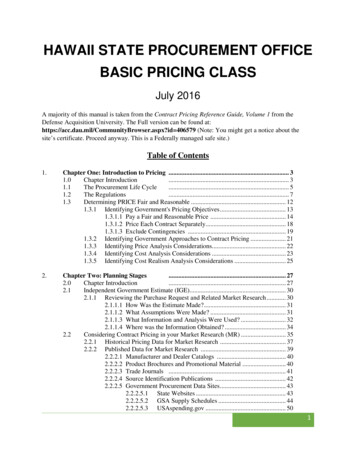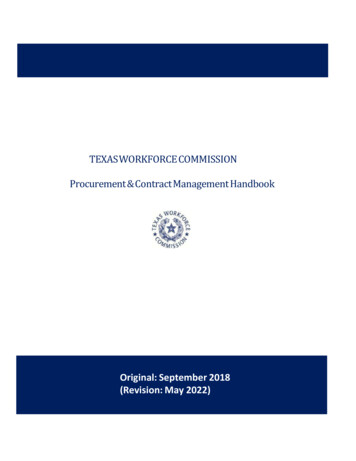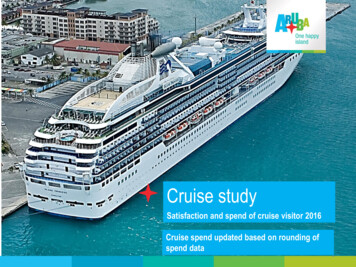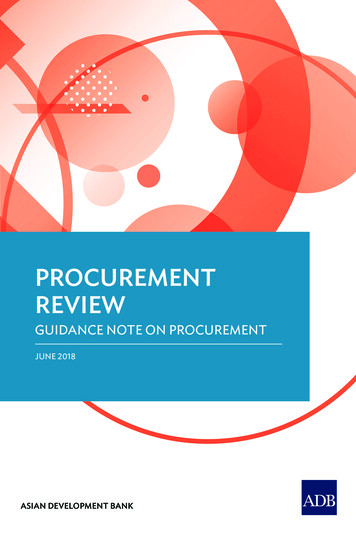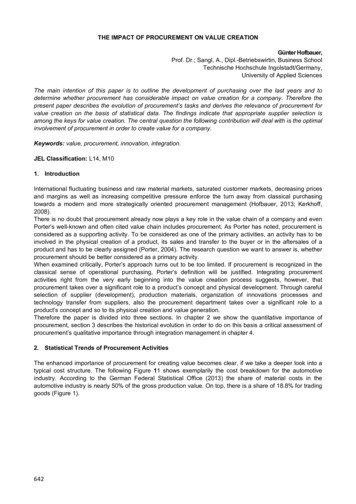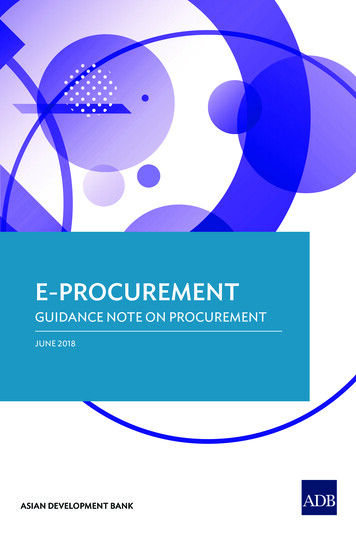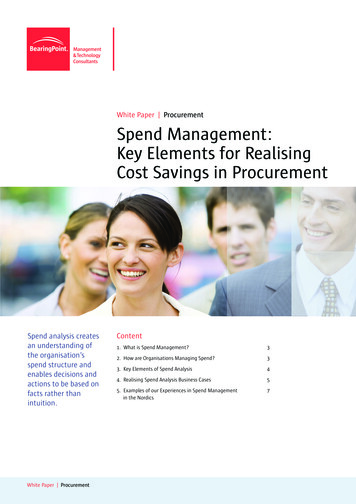
Transcription
White Paper ProcurementSpend Management:Key Elements for RealisingCost Savings in ProcurementSpend analysis createsan understanding ofthe organisation’sspend structure andenables decisions andactions to be based onfacts rather thanintuition.White Paper ProcurementContent1. What is Spend Management?32. How are Organisations Managing Spend?33. Key Elements of Spend Analysis44. Realising Spend Analysis Business Cases55. Examples of our Experiences in Spend Managementin the Nordics7
Focus on sourcing typically yields significant profits:a euro in increased sales is ten cents in profit whilea euro saved in costs is a euro increase in profit.IntroductionFigure 1. Increased outsourcing andspecialisation leads to lower valueadded. (Source: Teknikföretagen 2008.)Added value / Net revenue60In this white paper we discuss spend management and the actions that enable realisingthe saving potential revealed by spend analysis. We describe leading practices in usetoday, and present a path for achieving measurable cost savings in procurement.504030201001965Spend analysis forms a solid foundation for sourcing initiatives. It creates anunderstanding of the organisation’s spend structure and enables actions to be based onfacts rather than intuition. However, spend analysis does not create a return oninvestment itself: it just provides the necessary insight for focusing management’sattention on the procurement projects that appear to promise the highest return oninvestment.197219791986199320002007During the past decades the value added within organisations has decreased (See Figure1). In practice this means that a larger part of the end product’s or service’s value ispurchased from outside the organisation. This has increased importance of theprocurement function. More recently, the economic downturn has also increased theweight being put on procurement. According to an Aberdeen study (Aberdeen Group2009) 75 percent of European Chief Procurement Officers believe that their role withinthe organisation has gained importance due to the global recession.The procurement methodology of BearingPoint is presented in Figure 2. After eachphase, there are concrete deliverables that articulate the analysis and findings. In themethodology, spend analysis is conducted in the first phase. It aims to answer threebasic questions: what do we buy, who do we buy from, and how do we buy? Figure 2includes examples of these deliverables between the phases. In this white paper, wediscuss issues related to all four phases.Figure 2. BearingPoint Procurement MethodologyMarket &CompetitionMacroEconomyCategory C32%Category AMetricCategory BCurrent20082009Roles andresponsibilities2010Category CCategory D10%20DynamicSupply MarketsPrimary metrics [ m]Category E5%Category F4%8%K E SM15Category GCategory H25%10Cost11010510090Number of suppliers420350250200Delivery chnology5Purchase order complianceContractual compliance90%95%99%99%0Number of articles1504150410001000Unit AUnit BUnit CUnit DUnit EReports andreportingstructureEffectivemeetingsSecondary metrics [ KPIs)3%13%25Short intervalcontrolSupplier A Supplier B Supplier C Supplier D Supplier E Supplier FSpendanalysisSupply marketassessment2. Strategicplanning andcategory planning1. Spend capabilityanalysis2010 – Q3/Q42011WantedPositionCategoryValue Chain& SupplierStructureSMA, NewChannels &NegotiationSystems, Tools &MeasurementPersonnelWhite Paper 0%0%Aluminium coil54-21100%0%231-67Primary metrics[ m]MetricCategory planCurrent2008Current200920084. Follow-up 0Primary metrics[ m]MetricCurrent200820092010Number of suppliers420350250200Cost11010510090Primary metrics[ m]MetricCurrent200820092010Delivery accuracy95%95%98%98%Number of suppliers420350250200Cost11010510090Primarymetrics [ m]Secondary metrics[ m]Delivery accuracy95%95%98%98%Number of suppliers42035025020085%98%Purchase cs [ m]Delivery accuracy95%95%98%98%Contractual compliance90%99%Number of suppliers42095%35099%25020085%95%95%98%Purchase order complianceSecondary metrics [ m]Number of articles150410001000Delivery accuracy150495%95%98%98%Contractual compliance90%95%99%99%85%95%95%98%Purchase order complianceSecondarymetrics [ m]Number ofarticles1504150410001000Contractual compliance90%95%99%99%85%95%95%98%Purchase order complianceNumber of articles1504150410001000Contractual compliance90%95%99%99%Number of articlesRisks andLegal/AgreementsCapabilitydevelopment plan2Potentialsavings[ m]Plastic"Supplier Managementand DevelopmentCurrentspend[ m].2010 – Q1/Q2Volum econs.2009Strategy &OrganizationPurchasing processstructureManagementsystem3. Capabilitydevelopment andcategory realisationSuppliercons.CurrentRealityOverall targetmatrix1504150410001000Category target metrics
1. What is Spend Management?Spend management presents a holistic view of the activities involved in the “procureto-pay” process. This process includes, for example, sourcing, purchasing, goodsreceiving, payment settlement, and management of accounts payable and general ledgeraccounts. In short, spend management is the way in which organisations control theirspending. Whether the money is spent on goods or services for direct inputs (for exampleraw materials used in the manufacturing of products), indirect material (for exampleoffice supplies), or services (for example temporary and contract labour), organisationsneed a mechanism by which they are able to control and reduce costs related toprocurement.Procurement should berecognised as a bottom-linedriven activity contributingthrough reductions in endproducts’ costs and findingsuppliers with newinnovations.Successful spend management initiatives need to be aligned with the business strategyand have full commitment from the top management. Thus procurement should berecognised as a bottom-line driven activity contributing through reductions in endproducts’ costs and finding suppliers with new innovations.To be able to identify any sourcing opportunities, visibility to the current and pastspending is needed. This enables the buying organisation to enjoy a comprehensive viewon the metrics that drive improved cost and process efficiency as well as supply chainperformance through analysis of bottlenecks. Monitoring how well the suppliers arecurrently performing enables to see the need for development activities and thus thetargets for the future.2. How are Organisations Managing Spend?Unfortunately most organisations do not have an end-to-end view on their spending. Theneed for spend visibility is rather evident as it is noticed in a study by AMR Research:“From recent interviews with 70 supply management executives, we find that those thatdon’t utilize spend analytics have 55% on average of untapped spend, miss 10 % to 15 %in savings in categories that have never been examined, and miss at least 6 % in savingsper category currently managed” (Spend Visibility: Do You Have the Correct Lenses?, M.N. Rizza, AMR Research Inc., December 2009). The same study reveals that spend undermanagement varies considerably between different organisations: “AMR Research findsthat leading organisations have 65 %, while laggards have only 3 %” (ibid).This year the procurement department’s and CPO’s roles have been elevated as morepressure has been put on delivering cost reductions (See Figure 3). With the currenteconomic downturn, organisations should take a “back-to-basics” approach to uncoverthe potential cost saving opportunities in their purchases. This requires structured anddisciplined analysis of their spending. These opportunities stay mostly hidden becausemost organisations still do not have any formal spend management programs.If the organisation’s systems and processes do not provide timely and accurate spenddata, it can result in sourcing decisions being based on intuition rather than facts. Inaddition many organisations fail to realise the cost saving potential because they do notlink the spend analysis output to their strategic sourcing decisions. Considering the topfour pressures for procurement officers shown in Figure 3, it is logical that an increase insourcing activity is the most planned action for European Chief Purchasing Officers (CPOs)(See Figure 4).Figure 3. Top four challenges identifiedby EMEA-based Chief ProcurementOfficers (Source: Aberdeen GroupOctober performanceperformance52%29%25%Figure 4. Top strategic actions forEuropean Chief Procurement Officers .(Source: Aberdeen Group October shflowflowimprovecashDevelopsupplyDevelop 31%27%The foundation for efficient procurement is systematic analysis of spend data. It helpsorganisations to uncover the potential and required sourcing development activities.These activities may vary from renegotiating current contracts for better payment termsto insights on internal compliance with contracts, spending patterns, suppliercommitments, and supplier performance.White Paper Procurement3
3. Key Elements of Spend AnalysisSpend analysis should be the foundation on which sourcing initiatives are based on. Itcreates an understanding of the spend structure. The analysis is conducted by couplingspend data with analytical methods and tools.Figure 6. Data used for spend patternand performance analysisSuppliersodClientstructureGoThe focus should be in total consolidated spend, the suppliers, and purchased items. Animplication of spend analysis could, for example, be the forming of commodity groupsthat focus on selected spending areas and developing distinctive commodity strategies.At BearingPoint we consider spend analysis a five staged process where each step has itsown goals and methods (See Figure 5).Figure 5. Spend analysis process used at ionsItemCost centreInvoicesItems perorderFigure 7. Spend analysis architectureAccountspayableERP SystemGeneralLedgerExtract, Transform, portCumulative spend ( )Figure 8. Cumulative spend can revealthat purchases made from smallersuppliers should often be mergedtogether with larger suppliers80%15%5%Suppliers2Build spenddatabasePerformanceand spendpatternanalysis3Commodityprioritising andopportunityanalysis45Deep diveanalysisBusinesscase anddevelopmentroadmapIn the first phase spend data is gathered and processed in order to create a functionalspend database. The needed data consists of three dimensions with varying levels ofdetail: supplier, client structure, and goods (See Figure 6). Gathering the data oftenposes challenges because it must be collected from multiple information systems andother sources such as accounts payable, general ledger, and enterprise resourceplanning (ERP) systems. The data quality and structure is also usually highly uneven.Pulling the data together is often referred as extracting, transforming and loading (ETL).The spend data is then combined with needed master data of the organisation andimported to a data warehouse from where it can be used for analysis and reportingpurposes (See Figure 7).After collecting the data, it must be processed in order to assure its quality. Thecleansing process means taking out irrelevant and false information (for exampleduplicate entries or rows with typing errors) and unifying the data from differentsources. To provide a one-time spend analysis, it is possible to use simple spreadsheetmodels. However, for continuous spend analysis automatic and properly scalablesystems are required. In practice this means implementing professional spendmanagement software that is integrated to the organisation’s other informationsystems.The purpose of the second phase is to analyse the overall sourcing performance and thedetailed spend patterns of the organisation. The sourcing performance can be measuredby the capabilities related to sourcing strategy implementation, spend control, spendreduction, centralisation of buying, and supplier and contract management. Theperformance analysis requires selection of relevant key performance indicators, whichcan be compared to industry benchmarks.Spend pattern analysis provides detailed analysis of the organisation’s spend and thus isthe core of a spend analysis project. In practice, this means crunching the data (eitherautomatically with a suitable software or manually by using spreadsheets) in order tofind issues and pain points for the purchasing process. Deliverables can be, for example,spend distribution and number of suppliers of commodity categories, cumulative spend,and rate of common suppliers (See Figure 8). The information related to item spend andsuppliers of those items can be used for creating purchasing strategies for differentitems (See Figure 9).The third phase, commodity prioritisation and opportunity analysis, relies on theperformance and spend pattern analysis performed in the previous phase. In this phaserough cut saving potential and commodity groups are identified. The results are4White Paper Procurement
The fourth phase, deep dive analysis, focuses on digging deeper into selectedcommodity groups with the purpose of creating a better understanding the spendpattern. The target is to provide hypotheses on where and what to save from a total costperspective. Completing the deep dive analysis phase should result in a report percommodity group including a savings estimate and action points for implementation.The business case and roadmap development phase is the last phase in spend analysis.The target is to identify, quantify and present credible business cases and a roadmap fora strategic sourcing program. This means evaluating the return on investment of thedevelopment initiatives and then making decisions on whether to launch or reject aproject.Figure 9. The sourcing category matrixdeveloped by Peter Kraljic segregatescategories by their risk and complexityand spend/profit impact. It can be usedfor developing different purchasingstrategies. (Source: Kraljic 1983)Low Spend/profit impact Highbenchmarked against internal and external information. At BearingPoint, we useestablished market research company databases as well as our own internal experts toevaluate the saving potential. The identified cost saving opportunities are analysed inworkshops where they are prioritised and assigned for further deep dive analysis.Leverage ofpurchasing powerDiversify, balanceor exploitCommodity itemsStrategic itemsEfficient processingVolume assuranceTransactional itemsLowBottleneck itemsSourcing risk and complexityHigh4. Realising Spend Analysis Business CasesSpend analysis plays a crucial role throughout the entire supplier relationship life cycle,from cost cutting opportunity identification to contract compliance. Opportunitiesidentified through spend analysis are, however, not leveraged in most organisations.Next we will elaborate on the key activities required to realise spend analysis businesscases.Create a roadmap and assign responsibilitiesSpend analysis is followed by a detailed implementation roadmap that involves allcritical stakeholders. The roadmap includes, for example, prioritisation of the identifiedsourcing opportunities and an initial schedule for needed development activities torealise these opportunities. The outcome of spend analysis should be reviewed acrossbusiness functions in order to together determine the proper actions that are needed.A cross-functional review can also help in increasing spend under management asinformation and views are shared between organisational units.Organisational roles and responsibilities need to be assigned to start realising andtracking the targeted savings. Thus, in some cases the outcome of spend analysis canimpact the overall structure of the procurement organisation. As item categories areidentified, each category should have a manager assigned to coordinate theorganisation-wide procurement of the (category’s) items in question (See Figure 10).Each unit, on the other hand, should have a purchasing team responsible for theoperational purchasing activities.Leverage spend analysis to rationalise supplier base and to movetowards more strategic partnershipsAnalysing spend will help organisations to rationalise and categorise their supplier baseand focus on those suppliers that offer the best value. Supplier rationalisation mightinclude actions, for example, to consolidate spending if purchased volume is too muchspread to multiple suppliers in order to make better one-off deals.In some cases it can also be recommendable to agree strategic partnerships with thesuppliers of critical items. This usually means that there are also other importantvariables than just price, such as cooperation in research and development.When realising cost saving potentialrevealed by spend analysis,organisations should follow thesefour basic guidelines:1. Create a development roadmap2. Decide on key item categories3. Design and implement categorystrategy4. Track and measure resultsFigure 10. Assign organisation-widecategory management responsibilitiesto category managers. Each unit shouldhave a purchasing team to manageoperational purchasing.OrganisationCategory 1Unit AUnit BUnit CPurchasing teamPurchasing teamPurchasing teamCategorymanagerCategory 2CategorymanagerCategory 3CategorymanagerWhite Paper Procurement5
Gather facts to enable effective contract negotiationsTo be prepared for contract negotiations, organisations should estimate their bargainingposition and saving opportunities. Spend analysis is used to gather information of items’purchasing volumes throughout the organisation as well as prices demanded bydifferent suppliers. The overall spend volume per supplier should be identified across allbusiness units. Revealing the complete spend volume and value helps to strengthen theorganisation’s position in the contract negotiations.Getting the best price in the market requires also analysis on the supplier’s pricingpolicy. In some cases the ordering policy might incur additional costs. For example,transaction costs of ordering can be relatively higher if orders are made either too oftenor in too small amounts. The organisation might also be bearing costs due to poordelivery accuracy or, on the other hand, overly high reliability that is really not required.Tightening credit access across industries due to the financial crisis is showing theimportance of cash availability. Therefore new and current contracts should berenegotiated to gain better payment terms. In general, market knowledge is essential increating the right benchmark onto which the current contracts can be compared to.Building key metrics for allspend categories helps tomonitor progress and thusensure success in realisingthe cost saving targets andsourcing opportunities.Link spend analysis tightly with contract compliance and contractlifecycle managementStrategic sourcing can be viewed as a process that begins with spend analysis andcontinues through contract execution to tracking of contract compliance. History hasrepeatedly shown that even the best purchasing contracts deliver no savings if theorganisation and suppliers do not comply with them. Spend analysis and performancemanagement can help the procurement organisation to track compliance, identifyspending irregularities, and take needed corrective actions. Contract compliancetracking can also help to identify potential product or service related issues that need tobe addressed by the supplier or through internal training.Create metrics across all spend categories and utilise reports anddashboards to track changeBuilding key metrics for all spend categories helps to monitor progress and thus ensuresuccess in realising the cost saving targets and sourcing opportunities. The measuresrange from understanding the current performance of a category to detailed specificsupplier performance metrics. It is also critical for procurement professionals tomaintain trustworthiness by tracking actual savings. Management often complains thatsavings are identified but never realised or same savings are claimed for several projects.Enhance the internal category, supply market, and sourcing processexpertiseLeveraging spend data to enable more informed sourcing decisions requires commodityexpertise within entire procurement organisation. Understanding the historical buyingpatterns, accurate demand information, and clear purchasing requirements can enablesourcing professionals to develop requests for proposals and negotiate better contracts.This can lead to price discoveries and hence cost savings.6White Paper Procurement
5. Examples of our Experiences in Spend Managementin the NordicsMajor food producerBearingPoint conducted a one-time spend analysis in order to find saving possibilities inthe company’s buying methods. The analysis included direct purchasing, indirectpurchasing and trading goods purchasing. The analysis revealed possibilities in volumeand supplier consolidation as well as more competitive bidding. Category strategieswere also clarified. The analysis revealed a saving potential of over 3 million euro. Inorder to realise these savings detailed recommendations for improvement were made.Leading suppliers of lifting solutionsBearingPoint delivered an assessment of the procurement performance of the companyagainst best practices in order to create recommendations for improvement. Due to thecompany’s rapidly growing business volume, world class procurement was required tohandle rising procurement costs. In the starting point, the company’s procurement wasdecentralised and did not support spend analysis or strategic global sourcing.BearingPoint developed a procurement roadmap, which included a redesignedprocurement organisation, a plan to integrate procurement operations with the wholesupply chain, global sourcing pilots, and best practices for conducting spend analysis.Wholesaler of industrial and electrical productsBearingPoint helped to implement a consolidated sourcing approach to realise savings.This project involved a spend analysis indicating a major savings potential byaggregating spend across seven countries. BearingPoint also supported the client innegotiations with existing and potential suppliers based on a new sourcing methodologyin four commodity groups.Leading supplier of spirits and liquorsBearingPoint assisted the client with a variety of sourcing improvements. We conducteda spend analysis as part of a larger assessment of the clients procurement operations,and helped to redesign the procurement model. This included process redesign,organisation transition, improved IT set-up and negotiations with existing and potentialsuppliers. The client is now working actively with group-wide sourcing efforts based onBearingPoint’s methodology.White Paper Procurement7
We are BearingPoint.Management and Technology ConsultantsBearingPoint is an independent management and technology consultancy managedand owned by its Partners throughout Europe. Serving commercial, financial and publicservices clients, BearingPoint focuses on offering its clients the best possible value interms of tangible, measurable results by leveraging business and technology expertise.Its seamless cross-border approach, an entrepreneurial culture, long-standing relationswith reputable organisations, profound industry and functional knowledge as well assolutions customised to clients specific needs make the company a truly trustedadviser. BearingPoint has European roots, but operates with a global reach.To get there. Together.BearingPoint Finland OyPorkkalankatu 2000180 Helsinkiwww.bearingpoint.fi 2010 BearingPoint. All rights reserved. Printed in Finland.White Paper ProcurementContact personsRiku SantalaPartner, BearingPoint 358 40 532 2135riku.santala@bearingpointconsulting.comSamuli SyrjänenSenior Consultant, BearingPoint 358 40 708 8613samuli.syrjanen@bearingpointconsulting.com
don't utilize spend analytics have 55% on average of untapped spend, miss 10 % to 15 % in savings in categories that have never been examined, and miss at least 6 % in savings per category currently managed" (Spend Visibility: Do You Have the Correct Lenses?, M. N. Rizza, AMR Research Inc., December 2009).


